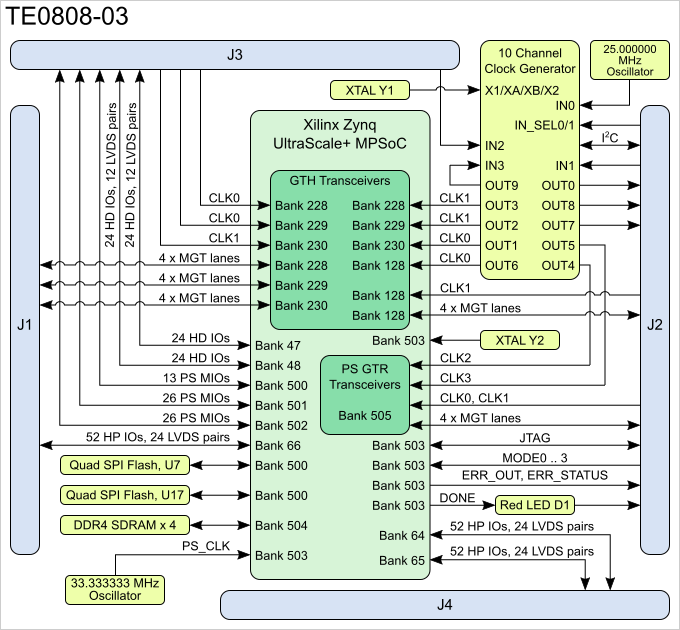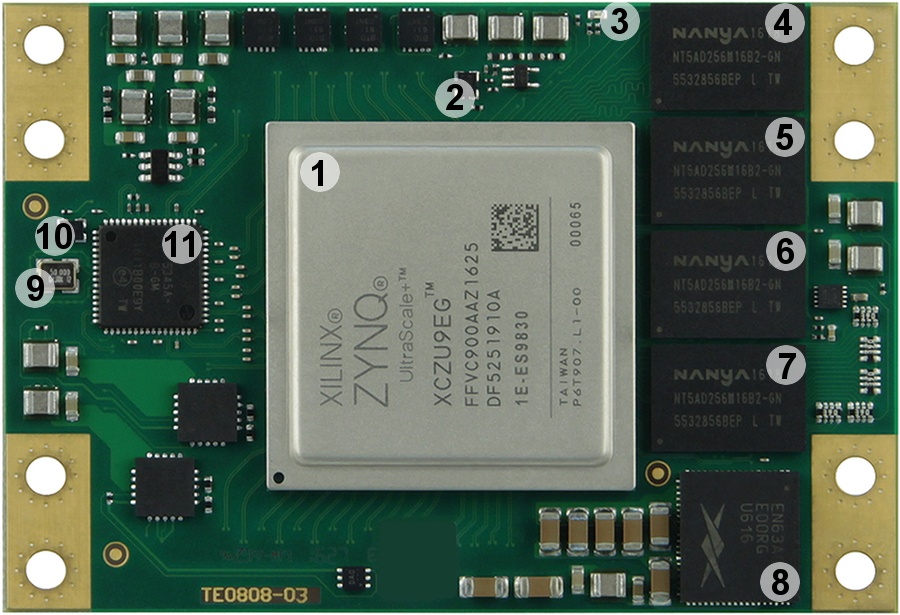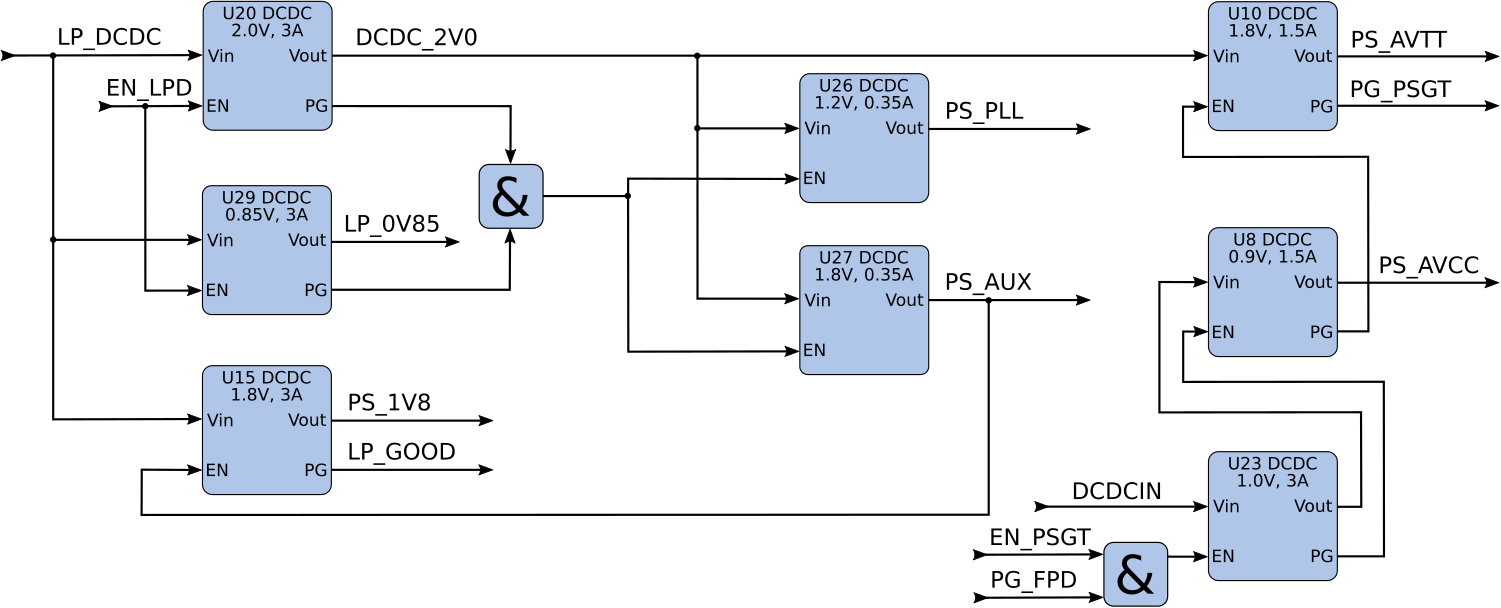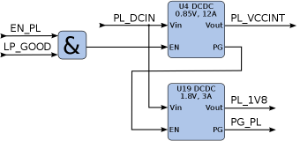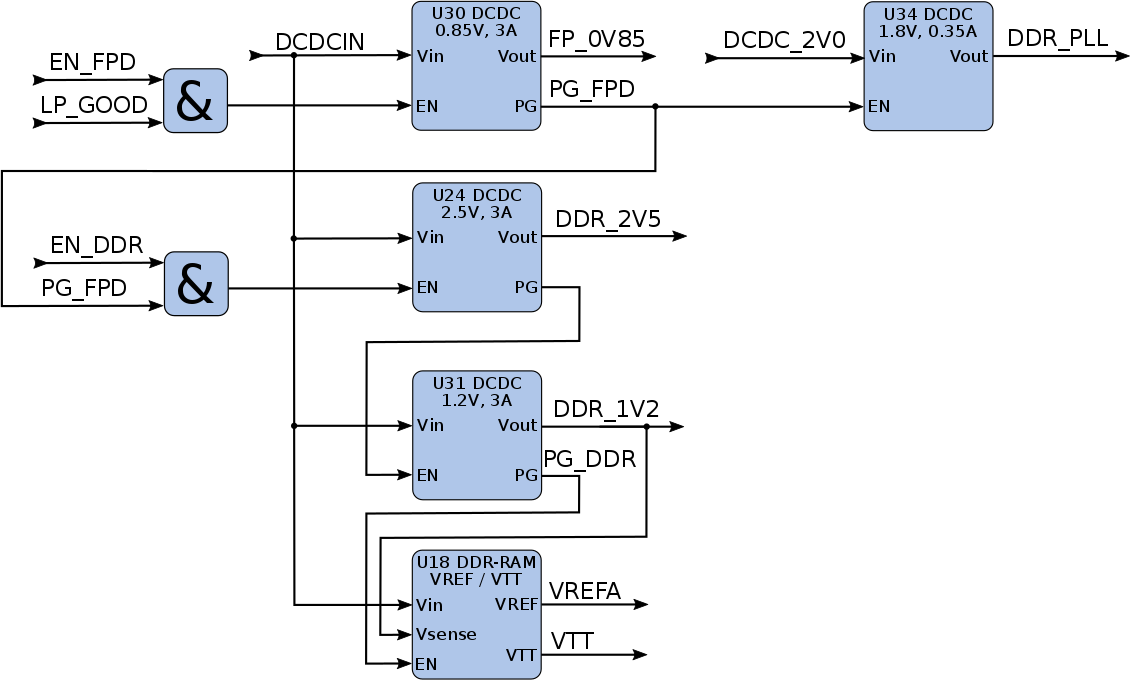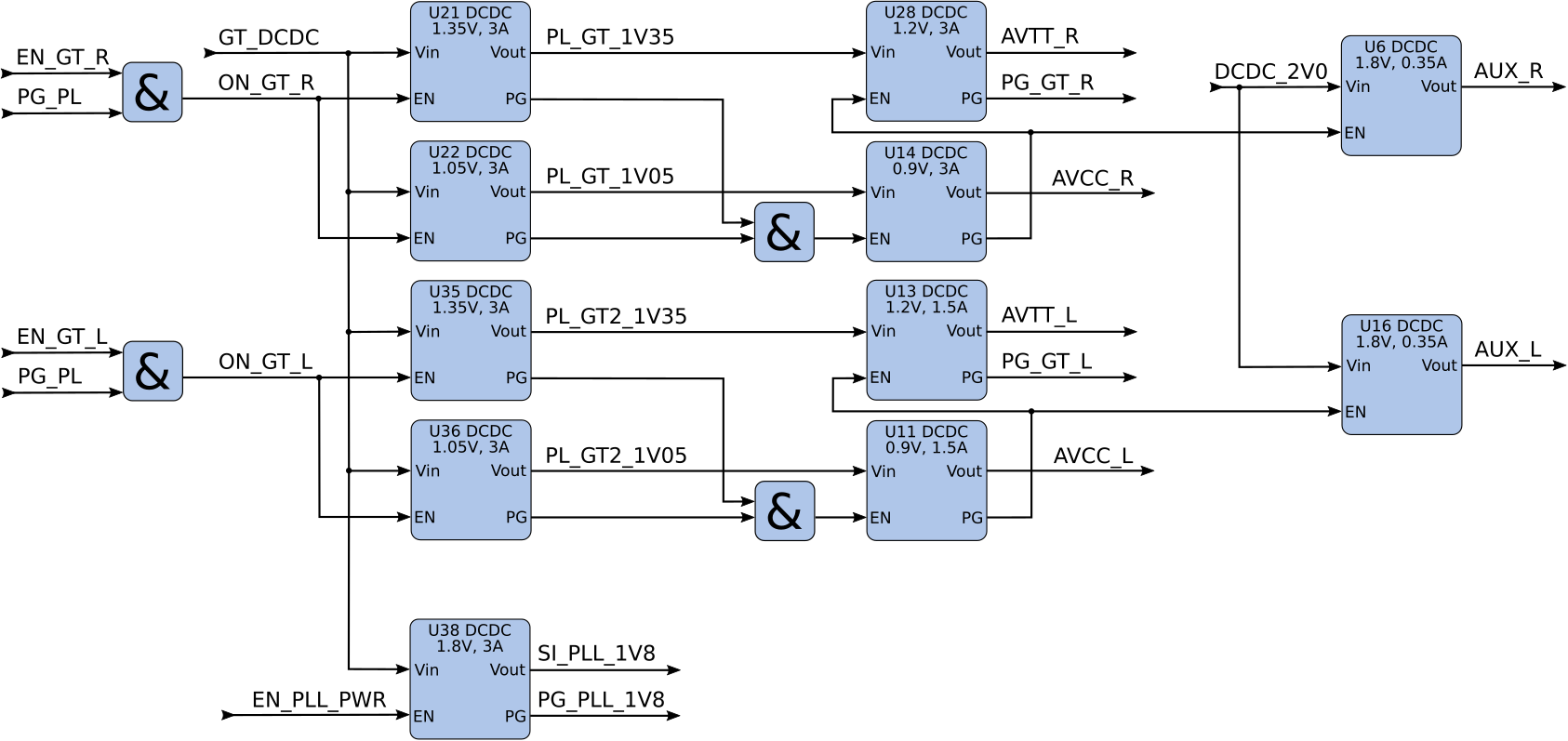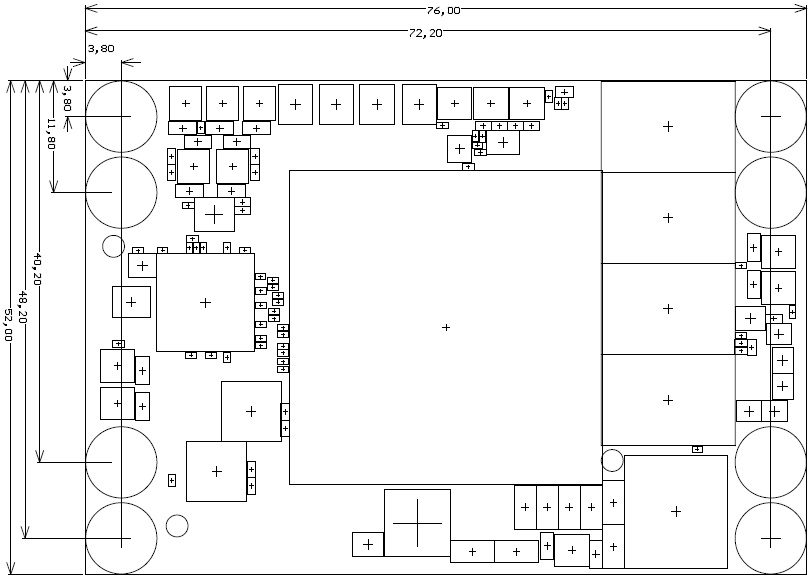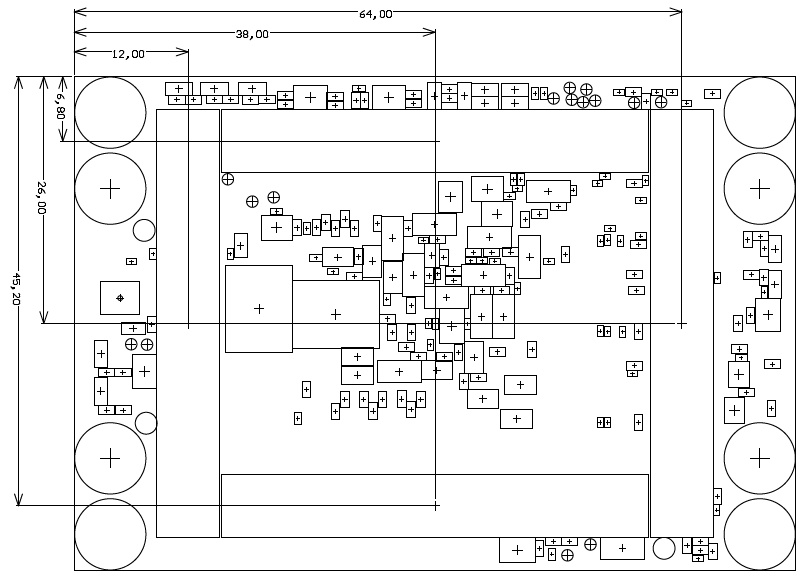Table of Contents
Overview
The Trenz Electronic TE0808 is an industrial-grade MPSoC UltraSoM integrating a Xilinx Zynq UltraScale+, max. 8 GByte DDR4 SDRAM with 64-Bit width databus connection, max. 512 MByte Flash memory for configuration and operation, 20 Gigabit transceivers, and powerful switch-mode power supplies for all on-board voltages. A large number of configurable I/O's is provided via rugged high-speed stacking connections.
Current TE0808 boards are equipped with ES1 silicon. Erratas and functional restrictions may exist, please check Xilinx documentation and contact your local Xilinx FAE for restrictions.
Block Diagram
Figure 1: TE0808-03 Block Diagram
Main Components
Figure 2: TE0808-03 MPSoC module
- Xilinx ZYNQ UltraScale+ XCZU9EG MPSoC, U1
- Low-power programmable oscillator @ 33.333333 MHz (PS_CLK), U32
- Red LED (DONE), D1
- 256Mx16 DDR4-2400 SDRAM, U12
- 256Mx16 DDR4-2400 SDRAM, U9
- 256Mx16 DDR4-2400 SDRAM, U2
- 256Mx16 DDR4-2400 SDRAM, U3
- 12A PowerSoC DCDC converter, U4
- Quartz crystal, Y1
- Low-power programmable oscillator @ 25.000000 MHz (IN0 for U5), U25
- 10-channel programmable clock generator, U5
- Ultra fine 0.50 mm pitch, Razor Beam™ LP Slim Terminal Strip with 160 contacts, J4
- Ultra fine 0.50 mm pitch, Razor Beam™ LP Slim Terminal Strip with 160 contacts, J2
- Ultra fine 0.50 mm pitch, Razor Beam™ LP Slim Terminal Strip with 160 contacts, J3
- Ultra fine 0.50 mm pitch, Razor Beam™ LP Slim Terminal Strip with 160 contacts, J1
- Quartz crystal, Y2
- 256 Mbit serial NOR Flash memory, U7
- 256 Mbit serial NOR Flash memory, U17
Key Features
- MPSoC: ZYNQ UltraScale+ ZU9EG 900 pin package
- Memory
- 64-Bit DDR4, 8 GByte maximum
- Dual SPI boot Flash in parallel, 512 MByte maximum - User I/O
- 65 x MIO, 48 x HD (all), 156 x HP (3 banks)
- Serial transceiver: 4 x GTR + 16 x GTH
- Transceiver clocks inputs and outputs
- PLL clock generator inputs and outputs - Size: 52 x 76 mm, 3 mm mounting holes for skyline heat spreader
- B2B connectors: 4 x 160 pin
- Si5345 - 10 output PLL
- All power supplies on board, single 3.3V power source required
- 14 on-board DCDC regulators and 13 LDOs
- LP, FP, PL separately controlled power domains - Support for all boot modes (except NAND) and scenarios
- Support for any combination of PS connected peripherals
Initial Delivery State
| Storage device name | Content | Notes |
|---|---|---|
SPI Flash main array | Not programmed | - |
eFUSE Security | Not programmed | - |
| Si5345A programmable PLL NVM | Not programmed | - |
Table 1: Initial Delivery State of the flash memories
Signals, Interfaces and Pins
Board to Board (B2B) connectors
The TE0808 MPSoC UltraSoM has four Board to Board (B2B) connectors with 160 contacts per connector.
Each connector has a specific arrangement of the signal-pins, which are grouped together in categories related to their functionalities and to their belonging to particular units of the Zynq Ultrascale+ MPSoC like I/O-banks, interfaces and Gigabit transceivers
or to the on-board peripheral ICs of the SoM.
Following table lists the I/O-bank signals, which are routed from the MPSoC's PL and PS banks as LVDS-pairs or single ended I/O's to the B2B connectors.
| Bank | Type | B2B Connector | Schematic names / Connector pins | I/O signal count | LVDS-pairs count | VCCO bank voltage | Notes |
|---|---|---|---|---|---|---|---|
| 47 | HD | J3 | B47_L1_P ... B47_L12_P | 24 I/O's | 12 | VCCO47 | VCCO max. 3.3V |
| 48 | HD | J3 | B48_L1_P ... B48_L12_P | 24 I/O's | 12 | VCCO48 | VCCO max. 3.3V |
| 64 | HP | J4 | B64_L1_P ... B64_L24_P | 48 I/O's | 24 | VCCO64 | VCCO max. 1.8V |
| 65 | HP | J4 | B65_L1_P ... B65_L24_P | 48 I/O's | 24 | VCCO65 | VCCO max. 1.8V |
| 64 | HP | J4 | B_64_T0 ... B_64_T3 | 4 I/O's | - | VCCO64 | VCCO max. 1.8V only single-ended I/O's |
| 65 | HP | J4 | B_65_T0 ... B_65_T3 | 4 I/O's | - | VCCO65 | VCCO max. 1.8V only single-ended I/O's |
| 66 | HP | J1 | B66_L1_P ... B66_L24_P | 48 I/O's | 24 | VCCO66 | VCCO max. 1.8V |
| 66 | HP | J1 | B_66_T0 ... B_66_T3 | 4 I/O's | - | VCCO66 | VCCO max. 1.8V |
| 500 | PSMIO | J3 | MIO13 ... MIO25 | 13 I/O's | - | PS_1V8 | - |
| 501 | PSMIO | J3 | MIO26 ... MIO51 | 26 I/O's | - | PS_1V8 | - |
| 502 | PSMIO | J3 | MIO52 ... MIO77 | 26 I/O's | - | PS_1V8 | - |
Table 2: B2B connector pin-outs of available PL and PS banks of the TE0808-03 SoM
For detailed information about the B2B pin-out, please refer to the Pin-out table.
MGT lanes
The B2B connector J1 and J2 provide also access to the MGT-banks of the Zynq Ultrascale+ MPSoC. There are 20 high-speed data lanes (Xilinx GTH / GTR transceiver) available composed as differential signaling pairs for both directions (RX/TX).
The MGT-banks have also clock input-pins which are exposed to the B2B connectors J2 and J3. Following MGT-lanes are available on the B2B connectors:
| Bank | Type | B2B Connector | count of MGT lanes | Schematic names / Connector pins | MGT bank's reference clock inputs (LVDS-pairs) |
|---|---|---|---|---|---|
| 228 | GTH | J1 | 4 GTH lanes | B228_RX3_P, B228_RX3_N, pins J1-27, J1-29 B228_RX2_P, B228_RX2_N, pins J1-33, J1-35 B228_RX1_P, B228_RX1_N, pins J1-39, J1-41 B228_RX0_P, B228_RX0_N, pins J1-45, J1-47 | 1 reference clock signal (B228_CLK0) from B2B connector 1 reference clock signal (B228_CLK1) from programmable |
| 229 | GTH | J1 | 4 GTH lanes | B229_RX3_P, B229_RX3_N, pins J1-27, J1-29 B229_RX2_P, B229_RX2_N, pins J1-33, J1-35 B229_RX1_P, B229_RX1_N, pins J1-39, J1-41 B229_RX0_P, B229_RX0_N, pins J1-45, J1-47 | 1 reference clock signal (B229_CLK0) from B2B connector 1 reference clock signal (B229_CLK1) from programmable |
| 230 | GTH | J1 | 4 GTH lanes | B230_RX3_P, B230_RX3_N, pins J1-3, J1-5 B230_RX2_P, B230_RX2_N, pins J1-9, J1-11 B230_RX1_P, B230_RX1_N, pins J1-15, J1-17 B230_RX0_P, B230_RX0_N, pins J1-21, J1-23 | 1 reference clock signal (B230_CLK1) from B2B connector 1 reference clock signal (B230_CLK0) from programmable |
| 128 | GTH | J2 | 4 GTH lanes | B128_RX3_N, B128_RX3_P, pins J2-28, J2-30 B128_RX2_N, B128_RX2_P, pins J2-34, J2-36 B128_RX1_N, B128_RX1_P, pins J2-40, J2-42 B128_RX0_N, B128_RX0_P, pins J2-46, J2-48 | 1 reference clock signal (B128_CLK1) from B2B connector 1 reference clock signal (B128_CLK0) from programmable |
| 505 | GTR | J2 | 4 GTR lanes | B505_RX3_N, B505_RX3_P, pins J2-52, J2-54 B505_RX2_N, B505_RX2_P, pins J2-58, J2-60 B505_RX1_N, B505_RX1_P, pins J2-64, J2-66 B505_RX0_N, B505_RX0_P, pins J2-70, J2-72 | 2 reference clock signals (B505_CLK0, B505_CLK1) from B2B connector 2 reference clock signal (B505_CLK2, B505_CLK3) from programmable |
Table 3: B2B connector pin-outs of available MGT-lanes of the MPSoC
JTAG Interface
JTAG access is provided through the MPSoC's PS configuration bank 503 with bank voltage 'PS_1V8'.
| JTAG Signal | B2B Connector pin |
|---|---|
| TCK | J2-120 |
| TDI | J2-122 |
| TDO | J2-124 |
| TMS | J2-126 |
Table 4: B2B connector pin-out of JTAG interface
Configuration bank control signals
The Xilinx Zynq Ultrascale+ MPSoC's PS configuration bank 503 control signal pins are accessible through B2B-connector J2.
| Signal | B2B Connector pin | Function |
|---|---|---|
| DONE | J2-116 | PL configuration completed |
| PROG_B | J2-100 | PL configuration reset signal |
| INIT_B | J2-98 | PS is initialized after a power-on reset |
| SRST_B | J2-96 | System reset |
| MODE0 ... MODE3 | J2-109/J2-107/J2-105/J2-103 | 4-bit boot mode pins For further information about the boot-modes refer to the Xilinx Zynq Ultrascale+ TRM 'ug1085'. |
| ERR_STATUS / ERR_OUT | J2-86 / J2-88 | ERR_OUT signal is asserted for accidental loss of ERR_STATUS indicates a secure lockdown state |
| PUDC_B | J2-127 | Pull-up during configuration (pulled-up to 'PL_1V8') |
Table 5: B2B connector pin-out of MPSoC's PS configuration bank
Analog Input
The Xilinx Zynq Ultrascale+ MPSoC provides input-pins for differential analog values. The pins are exposed to B2B-connector J2.
| Signal | B2B Connector pin | Function |
|---|---|---|
| V_P, V_N | J2-113, J2-115 | System Monitor |
| DX_P, DX_N | J2-119, J2-121 | Temperature-sensing diode pins |
Table 6: B2B connector pin-out of analog input pins
Quad-SPI Flash memory
The TE0808-03 SoM is equipped with two Serial Flash Memory with up to 512 Mbyte storage capacity each. The flash memory ICs with the schematic designators U7 and U17 are connected to bank 500 (PSMIO) of the Zynq MPSoC module via QSPI interface, enabling a 8-Bit width databus connection.
Following table shows the mapping of the MIO-pins to the flash memory ICs.
| Flash Memory IC U7 | Flash Memory IC U7 | |||||
|---|---|---|---|---|---|---|
| MIO | Function | Notes | MIO | Function | Notes | |
| 0 | CLK | Clock | 7 | CS | Chip-select (low-active) | |
| 1 | DQ1 | Serial Data (Output and I/O) | 8 | DQ0 | Serial Data (Input and I/O) | |
| 2 | DQ2 | Serial Data (Input and I/O) | 9 | DQ1 | Serial Data (Output and I/O) | |
| 3 | DQ3 | Serial Data (Input and I/O) | 10 | DQ2 | Serial Data (Input and I/O) | |
| 4 | DQ0 | Serial Data (Input and I/O) | 11 | DQ3 | Serial Data (Input and I/O) | |
| 5 | CS | Chip-select (low-active) | 12 | CLK | Clock | |
Table 7: Flash memory QSPI-interface
DDR4 SDRAM
The TE0808-03 UltraSoM is equipped with with four DDR4-2400 SDRAM modules with up to 8 Gbyte memory density. The SDRAM modules are connected to the Zynq MPSoC's PS DDR-controller (bank 504) with a 64-bit databus width.
LEDs
TE0808 has one red LED (D1) which reflects MPSoC's 'DONE' signal. This LED goes ON when power has been applied to the module and stays ON until MPSoC's programmable logic is configured properly.
Clocking
Programmable Clock Generator
Following table illustrates on-board Si5345A programmable clock multiplier chip inputs and outputs:
| Input/Output | Connected to | Frequency | Notes |
|---|---|---|---|
| IN0 | On-board Oscillator (U25) | 25.000000 MHz | - |
| IN1 | B2B Connector pins J2-3, J2-1 (differential pair) | User | AC decoupling required on base |
| IN2 | B2B Connector pins J3-66, J3-68 (differential pair) | User | AC decoupling required on base |
| IN3 | OUT9 | User | Loop-back from OUT9 |
| OUT0 | B2B Connector pins J2-3, J2-1 (differential pair) | User | Default off |
| OUT1 | B230 CLK0 | User | Default off |
| OUT2 | B229 CLK1 | User | Default off |
| OUT3 | B228 CLK1 | User | Default off |
| OUT4 | B505 CLK2 | User | Default off |
| OUT5 | B505 CLK3 | User | Default off |
| OUT6 | B128 CLK0 | User | Default off |
| OUT7 | B2B Connector pins J2-7, J2-9 (differential pair) | User | Default off |
| OUT8 | B2B Connector pins J2-13, J2-15 (differential pair) | User | Default off |
| OUT9 | IN3 (Loop-back) | User | Default off |
| XA/XB | Quartz (Y1) | 50.000 MHz | - |
Table 8: Programmable PLL clock generator input/output
The Si5345A programmable clock generator's control interface pins are exposed to B2B connector J2. For further information refer to the Si5345A data sheet.
| Signal | B2B Connector pin | Function |
|---|---|---|
| PLL_FINC | J2-81 | Frequency Increment |
| PLL_LOLN | J2-85 | Loss Of Lock (low-active) |
| PLL_SEL0 / PLL_SEL1 | J2-93 / J2-87 | Manual Input Switching |
| PLL_FDEC | J2-94 | Frequency Decrement |
| PLL_RST | J2-59 | Device Reset (low-active) |
| PLL_SCL / PLL_SDA | J2-90 / J2-92 | I²C interface, needed extern pull-ups. I²C address in current configuration: 1101010b |
Table 9: B2B connector pin-out of Si5345A programmable clock generator
The TE0808-03 SoM is equipped with two on-board oscillators to provide the Zynq's MPSoC's PS configuration bank 503 with reference clock-signals.
| Clock | Frequency | Bank 503 Pin | Connected To |
|---|---|---|---|
| PS_CLK | 33.333333 MHz | P20 | MEMS Oscillator, U32 |
| PS_PAD (RTC) | 32.768 kHz | R22/R23 | Quartz crystal, Y2 |
Table 10: Reference clock-signals to PS configuration bank 503
Power and Power-On Sequence
Power supply with minimum current capability of 3A for system startup is recommended. For the lowest power consumption and highest efficiency of on board DC/DC regulators it is recommended to powering the module from one single 3.3V supply. All input power supplies have a nominal value of 3.3V. Although the input power supplies can be powered up in any order, it is recommended to power them up simultaneously.
The TE0808-03 module with the Xilinx Zynq Ultrascale+ MPSoC delivers a heterogeneous multi-processing system with integrated programmable logic and independently operable elements and is designed to meet embedded system power management requirement by advanced power management features. This features allow to offset the power and heat constraints against overall performance and operational efficiency.
This features allowing highly flexible power management are achieved by establishing Power Domains for power isolation. The Zynq Ultrascale+ MPSoC has multiple power domains, whereby each power domain requires its particular extern DCDC converters.
The Processing System contains three Power Domains:
- Battery Power Domain (BBRAM and RTC)
- Full-Power Domain (Application Processing Unit, DDR Controller, Graphics Processing Unit and High-Speed Connectivity)
- Low-Power Domain (Real-Time Processing Unit, Security and Configuration Unit, Platform Management Unit, System Monitor and General Connectivity)
The fourth Power Domain is for the Programmable Logic (PL). If individual Power Domain control is not required, power rails can be shared between domains.
On the TE0808-03 SoM, following Power Domains can be powered up individually with power rails available on the B2B connectors:
- Full-Power Domain, supplied by power rail 'DCDCIN'
- Low-Power Domain, supplied by power rail 'LP_DCDC'
- Programmable Logic, supplied by power rail 'PL_DCIN'
- Battery Power Domain, supplied by power rail 'PS_BATT'
Each Power Domain has its own "Enabling"- and "Power Good"-signal. The power rail 'GT_DCDC' is necessary for generating the supply voltages for the high speed Gigabit Transceivers units of the Zynq Ultrascale+ MPSoC.
Power-On Sequence utilizing DCDC control signals
To power up the TE0808-03 SoM properly, a specific sequence must be kept of enabling the on-board DCDC converters dedicated to the particular Power Domains and powering up the on-board voltages.
The first activated Power Domain is the Low-Power Domain. Therefore, the power rail 'LP_DCDC' have to be powered up and the Enable-signal 'EN_LPD' (pin J2-108, 7V max.) have to be asserted. The resulting Power-Good-Signal 'LP_GOOD' (pin J2-106) will go high after the voltages of the Low-Power Domain are properly powered up.
Figure 3: Low-Power Domain
The second activated Power Domain is the Programmable Logic. Therefore, the power rail 'PL_DCIN' have to be powered up and the Enable-signal 'EN_PL' (pin J2-101) have to be asserted by pulling this pin up to the voltage 'LP_DCDC' or left floating (drive to GND for disabling). The resulting Power-Good-Signal 'PG_PL' (pin J2-104) will go high after the voltages of the Programmable Logic Domain are properly powered up. The signal 'PG_PL' needs an extern pull-up (max. voltage 'GT_DCDC').
Figure 4: Programmable Logic Domain
Also as second activated Power Domain is the Full-Power Domain. Therefore, the power rail 'DCDCIN' have to be powered up and the Enable-signals 'EN_FPD' (pin J2-102) and 'EN_DDR' (J2-112) have to be asserted (max. voltage 'DCDCIN'). The resulting Power-Good-Signals 'PG_FPD' (pin J2-110) and 'PG_DDR' (J2-114) will go high after the voltages of the Programmable Logic Domain are properly powered up. In the following, the PSGT voltages (see figure 3) can be powered up by asserting the Enable-signal 'EN_PSGT' (pin J2-84, max. voltage 'DCDCIN'). The resulting Power-Good-Signal 'PG_PSGT' (pin J2-82) needs an extern pull-up (max. 6V).
Figure 5: Full-Power Domain
The supply voltages for the MGT units of the MPSoC will be powered up last. Therefore, the power rail 'GT_DCDC' have to be powered up and the Enable-signals 'EN_GT_R' (pin J2-95), 'EN_GT_L' (pin J2-79) and 'EN_PLL_PWR' (J2-77, 7V max.) have to be asserted (max. voltage 'GT_DCDC'). The resulting Power-Good-Signals 'PG_GT_R' (pin J2-91), 'PG_GT_L' (pin J2-97) and 'PG_PLL_1V8' (J2-80) will go high after the voltages of the Programmable Logic Domain are properly powered up. The three Power-Good-Signals need an extern pull-up (max. 6V).
Figure 6: Powering up MGT supply voltages
The voltages 'LP_DCDC' and 'LP_0V85' are monitored by a the voltage monitor circuit U41, which generates the POR_B signal at Power-On. A manual reset is also possible the driving the MR-pin (J2-83) to GND. Leave unconnected or connect to VDD (LP_DCDC) when unused.
Figure 7: Voltage monitor circuit
Core voltages and main supply voltages have to reach stable state and their "Power Good"-signals have to be asserted before other voltages like bank's I/O voltages (VCCOx) can be powered up.
It is important that all PS and PL I/Os are 3-stated at power-on until the "Power Good"-signals are high, meaning that all on-module voltages have become stable and module is properly powered up.
See Xilinx datasheet DS925 for additional information. User should also check related base board documentation when intending base board design for TE0808-03 SoM.
Power Rails
Voltages on B2B | B2B J1 Pin | B2B J2 Pin | B2B J3 Pin | B2B J4 Pin | Input/ | Note |
|---|---|---|---|---|---|---|
| PL_DCIN | J1-151, J1-153, J1-157, J1-159 | - | - | - | Input | - |
| DCDCIN | - | J2-154, J2-156, J2-158, J2-160, | - | - | Input | - |
| LP_DCDC | - | J2-138, J2-140, J2-142, J2-144 | - | - | Input | - |
| PS_BATT | - | J2-125 | - | - | Input | - |
| GT_DCDC | - | - | J3-157, J3-158, J3-159, J3-160 | - | Input | - |
| PLL_3V3 | - | - | J3-152 | - | Input | U5 (programmable PLL) 3.3V nominal input |
| SI_PLL_1V8 | - | - | J3-151 | - | Output | Internal voltage level 1.8V nominal output |
| PS_1V8 | - | J2-99 | J3-148 | - | Output | Internal voltage level |
| PL_1V8 | J1-91, J1-121 | - | - | - | Output | Internal voltage level |
| DDR_1V2 | - | J2-135 | - | - | Output | Internal voltage level |
Table 15: Power rails of the MPSoC module on accessible connectors
Bank Voltages
| Bank | Type | Schematic Name / B2B connector pins | Voltage | Reference Input Voltage | Voltage Range |
|---|---|---|---|---|---|
| 47 | HD | VCCO47, pins J3-43, J3-44 | user | - | max. 3.3V |
| 48 | HD | VCCO48, pins J3-15, J3-16 | user | - | max. 3.3V |
| 64 | HP | VCCO64, J4-58, J4-106 | user | VREF_64, pin J4-88 | max. 1.8V |
| 65 | HP | VCCO65, J4-69, J4-105 | user | VREF_65, pin J4-15 | max. 1.8V |
| 66 | HP | VCCO66, J1-90, J1-120 | user | VREF_66, pin J1-108 | max. 1.8V |
| 500 | PSMIO | PS_1V8 | 1.8V | - | - |
| 501 | PSMIO | PS_1V8 | 1.8V | - | - |
| 502 | PSMIO | PS_1V8 | 1.8V | - | - |
| 503 | PSCONFIG | PS_1V8 | 1.8V | - | - |
Table 16: Range of MPSoC module's bank voltages
B2B connectors
Technical Specifications
Absolute Maximum Ratings
Parameter | Min | Max | Unit | Notes / Reference Document |
|---|---|---|---|---|
| PL_DCIN | -0.3 | 7 | V | TPS82085SIL/EN63A0QI data sheet |
| DCDCIN | -0.3 | 7 | V | TPS82085SIL/TPS51206PSQ data sheet |
| LP_DCDC | -0.3 | 4 | V | TPS3106K33DBVR data sheet |
| GT_DCDC | -0.3 | 7 | V | TPS82085SIL data sheet |
| PS_BATT | -0.5 | 2 | V | Xilinx DS925 data sheet |
| PLL_3V3 | -0.5 | 3.8 | V | Si5345/44/42 data sheet |
| VCCO for HD I/O banks | -0.5 | 3.4 | V | Xilinx DS925 data sheet |
| VCCO for HP I/O banks | -0.5 | 2 | V | Xilinx DS925 data sheet |
| VREF | -0.5 | 2 | V | Xilinx DS925 data sheet |
| I/O input voltage for HD I/O banks | -0.55 | VCCO + 0.55 | V | Xilinx DS925 data sheet |
| I/O input voltage for HP I/O banks | -0.55 | VCCO + 0.55 | V | Xilinx DS925 data sheet |
| PS I/O input voltage (MIO pins) | -0.5 | VCCO_PSIO + 0.55 | V | Xilinx DS925 data sheet, VCCO_PSIO 1.8V nominally |
Receiver (RXP/RXN) and transmitter | -0.5 | 1.2 | V | Xilinx DS925 data sheet |
Voltage on input pins of | -0.5 | VCC + 0.5 | V | NC7S08P5X data sheet, see schematic for VCC |
Voltage on input pins (nMR) of | -0.3 | VDD + 0.3 | V | TPS3106 data sheet, |
| "Enable"-signals on TPS82085SIL ('EN_PLL_PWR', 'EN_LPD') | -0.3 | 7 | V | TPS82085SIL data sheet |
Storage temperature (ambient) | –40 | 125 | °C | TPS82085SIL data sheet |
Recommended Operating Conditions
| Parameter | Min | Max | Unit | Notes / Reference Document |
|---|---|---|---|---|
| PL_DCIN | 1.8 | 6 | V | TPS82085SIL data sheet |
| DCDCIN | 3.1 | 6 | V | TPS82085SIL/TPS51206PSQ data sheet |
| LP_DCDC | 2.0 | 3.6 | V | TPS3106K33DBVR data sheet |
| GT_DCDC | 1.8 | 6 | V | TPS82085SIL data sheet |
| PS_BATT | 1.2 | 1.5 | V | Xilinx DS925 data sheet |
| PLL_3V3 | 3.14 | 3.47 | V | Si5345/44/42 data sheet 3.3V typical |
| VCCO for HD I/O banks | 1.14 | 3.4 | V | Xilinx DS925 data sheet |
| VCCO for HP I/O banks | 0.95 | 1.9 | V | Xilinx DS925 data sheet |
| I/O input voltage for HD I/O banks. | -0.2 | VCCO + 0.2 | V | Xilinx DS925 data sheet |
| I/O input voltage for HP I/O banks | -0.2 | VCCO + 0.2 | V | Xilinx DS925 data sheet |
| PS I/O input voltage (MIO pins) | -0.2 | VCCO_PSIO + 0.2 | V | Xilinx DS925 data sheet, VCCO_PSIO 1.8V nominally |
| Voltage on input pins of NC7S08P5X 2-Input AND Gate | 0 | VCC | V | NC7S08P5X data sheet, |
Voltage on input pins (MR) of | 0 | VDD | V | TPS3106 data sheet, |
Physical Dimensions
Module size: 52 mm × 76 mm. Please download the assembly diagram for exact numbers
Mating height with standard connectors: 4mm
PCB thickness: 1.6mm
Highest part on PCB: approx. 3mm. Please download the step model for exact numbers
All dimensions are given in millimeters.
Operating Temperature Ranges
Commercial grade: 0°C to +70°C.
Industrial grade: -40°C to +85°C.
-40 ... 125 TPS82085SIL data sheet
The module operating temperature range depends also on customer design and cooling solution. Please contact us for options.
Weight
17 g - Plain module
Revision History
Hardware Revision History
| Date | Revision | Notes | Link to PCN | Documentation Link |
|---|---|---|---|---|
| - | 03 | Second production release | - | TE0808-03 |
| 2016-03-09 | 02 | First production release | - | TE0808-02 |
| - | 01 | Prototypes | - | - |
Hardware revision number is written on the PCB board together with the module model number separated by the dash.
Document Change History
| Date | Revision | Contributors | Description |
|---|---|---|---|
| 2017-02-06 | Jan Kumann | Initial document. |
Disclaimer
Data Privacy
Please also note our data protection declaration at https://www.trenz-electronic.de/en/Data-protection-Privacy
Document Warranty
The material contained in this document is provided “as is” and is subject to being changed at any time without notice. Trenz Electronic does not warrant the accuracy and completeness of the materials in this document. Further, to the maximum extent permitted by applicable law, Trenz Electronic disclaims all warranties, either express or implied, with regard to this document and any information contained herein, including but not limited to the implied warranties of merchantability, fitness for a particular purpose or non infringement of intellectual property. Trenz Electronic shall not be liable for errors or for incidental or consequential damages in connection with the furnishing, use, or performance of this document or of any information contained herein.
Limitation of Liability
In no event will Trenz Electronic, its suppliers, or other third parties mentioned in this document be liable for any damages whatsoever (including, without limitation, those resulting from lost profits, lost data or business interruption) arising out of the use, inability to use, or the results of use of this document, any documents linked to this document, or the materials or information contained at any or all such documents. If your use of the materials or information from this document results in the need for servicing, repair or correction of equipment or data, you assume all costs thereof.
Copyright Notice
No part of this manual may be reproduced in any form or by any means (including electronic storage and retrieval or translation into a foreign language) without prior agreement and written consent from Trenz Electronic.
Technology Licenses
The hardware / firmware / software described in this document are furnished under a license and may be used /modified / copied only in accordance with the terms of such license.
Environmental Protection
To confront directly with the responsibility toward the environment, the global community and eventually also oneself. Such a resolution should be integral part not only of everybody's life. Also enterprises shall be conscious of their social responsibility and contribute to the preservation of our common living space. That is why Trenz Electronic invests in the protection of our Environment.
REACH, RoHS and WEEE
REACH
Trenz Electronic is a manufacturer and a distributor of electronic products. It is therefore a so called downstream user in the sense of REACH. The products we supply to you are solely non-chemical products (goods). Moreover and under normal and reasonably foreseeable circumstances of application, the goods supplied to you shall not release any substance. For that, Trenz Electronic is obliged to neither register nor to provide safety data sheet. According to present knowledge and to best of our knowledge, no SVHC (Substances of Very High Concern) on the Candidate List are contained in our products. Furthermore, we will immediately and unsolicited inform our customers in compliance with REACH - Article 33 if any substance present in our goods (above a concentration of 0,1 % weight by weight) will be classified as SVHC by the European Chemicals Agency (ECHA).
RoHS
Trenz Electronic GmbH herewith declares that all its products are developed, manufactured and distributed RoHS compliant.
WEEE
Information for users within the European Union in accordance with Directive 2002/96/EC of the European Parliament and of the Council of 27 January 2003 on waste electrical and electronic equipment (WEEE).
Users of electrical and electronic equipment in private households are required not to dispose of waste electrical and electronic equipment as unsorted municipal waste and to collect such waste electrical and electronic equipment separately. By the 13 August 2005, Member States shall have ensured that systems are set up allowing final holders and distributors to return waste electrical and electronic equipment at least free of charge. Member States shall ensure the availability and accessibility of the necessary collection facilities. Separate collection is the precondition to ensure specific treatment and recycling of waste electrical and electronic equipment and is necessary to achieve the chosen level of protection of human health and the environment in the European Union. Consumers have to actively contribute to the success of such collection and the return of waste electrical and electronic equipment. Presence of hazardous substances in electrical and electronic equipment results in potential effects on the environment and human health. The symbol consisting of the crossed-out wheeled bin indicates separate collection for waste electrical and electronic equipment.
Trenz Electronic is registered under WEEE-Reg.-Nr. DE97922676.
